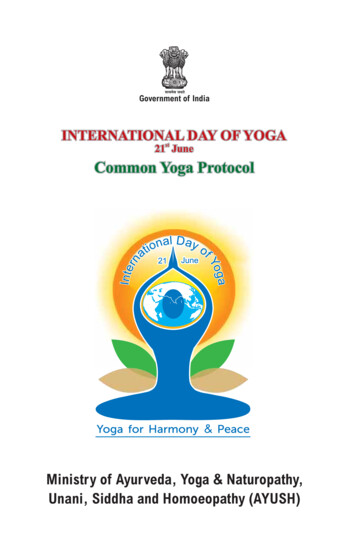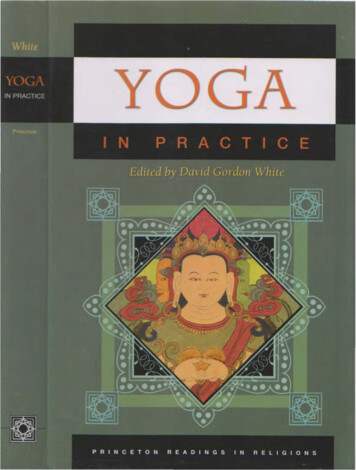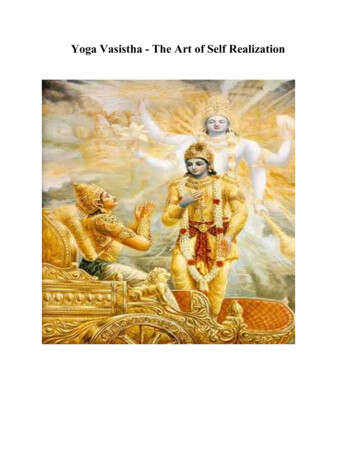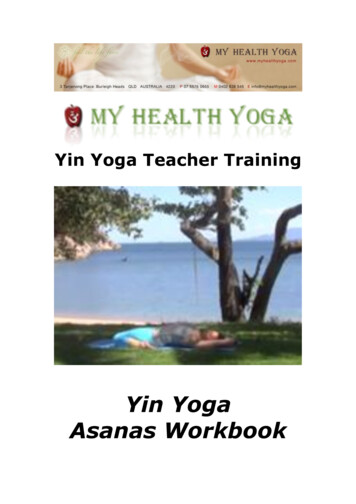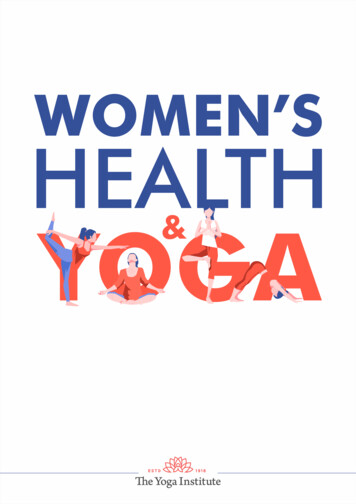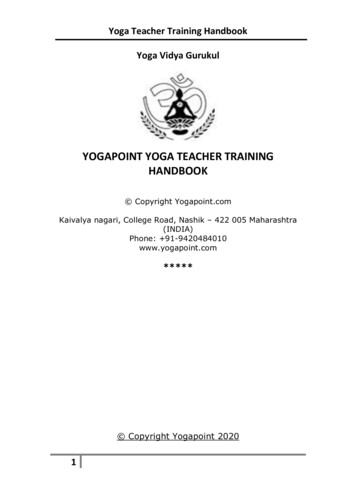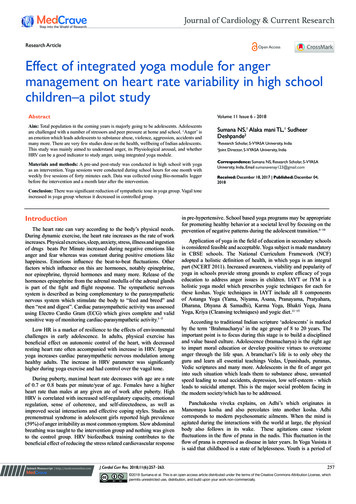
Transcription
Journal of Cardiology & Current ResearchResearch ArticleOpen AccessEffect of integrated yoga module for angermanagement on heart rate variability in high schoolchildren–a pilot studyAbstractVolume 11 Issue 6 - 2018Aim: Total population in the coming years is majorly going to be adolescents. Adolescentsare challenged with a number of stressors and peer pressure at home and school. ‘Anger’ isan emotion which leads adolescents to substance abuse, violence, aggression, accidents andmany more. There are very few studies done on the health, wellbeing of Indian adolescents.This study was mainly aimed to understand anger, its Physiological arousal, and whetherHRV can be a good indicator to study anger, using integrated yoga module.Materials and methods: A pre-and post-study was conducted in high school with yogaas an intervention. Yoga sessions were conducted during school hours for one month withweekly five sessions of forty minutes each. Data was collected using Bio-nomadix loggerbefore the intervention and a month later after the intervention.Sumana NS,1 Alaka mani TL,1 SudheerDeshpande2Research Scholar, S-VYASA University, India1Joint Director, S-VYASA University, India2Correspondence: Sumana NS, Research Scholar, S-VYASAUniversity, India, EmailReceived: December 18, 2017 Published: December 04,2018Conclusion: There was significant reduction of sympathetic tone in yoga group. Vagal toneincreased in yoga group whereas it decreased in controlled group.IntroductionThe heart rate can vary according to the body’s physical needs.During dynamic exercise, the heart rate increases as the rate of workincreases. Physical exercises, sleep, anxiety, stress, illness and ingestionof drugs beats Per Minute increased during negative emotions likeanger and fear whereas was constant during positive emotions likehappiness. Emotions influence the beat-to-beat fluctuations. Otherfactors which influence on this are hormones, notably epinephrine,nor epinephrine, thyroid hormones and many more. Release of thehormones epinephrine from the adrenal medulla of the adrenal glandsis part of the fight and flight response. The sympathetic nervoussystem is described as being complementary to the parasympatheticnervous system which stimulate the body to “feed and breed” andthen “rest and digest”. Cardiac parasympathetic activity was assessedusing Electro Cardio Gram (ECG) which gives complete and validsensitive way of monitoring cardiac-parasympathetic activity.1 5Low HR is a marker of resilience to the effects of environmentalchallenges in early adolescence. In adults, physical exercise hasbeneficial effect on autonomic control of the heart, with decreasedresting heart rate often accompanied with increase in HRV. Iyengaryoga increases cardiac parasympathetic nervous modulation amonghealthy adults. The increase in HRV parameter was significantlyhigher during yoga exercise and had control over the vagal tone.During puberty, maximal heart rate decreases with age are a rateof 0.7 or 0.8 beats per minute/year of age. Females have a higherheart rate than males at any given ate of work after puberty. HighHRV is correlated with increased self-regulatory capacity, emotionalregulation, sense of coherence, and self-directedness, as well asimproved social interactions and effective coping styles. Studies onpremenstrual syndrome in adolescent girls reported high prevalence(59%) of anger irritability as most common symptom. Slow abdominalbreathing was taught to the intervention group and nothing was givento the control group. HRV biofeedback training contributes to thebeneficial effect of reducing the stress related cardiovascular responseSubmit Manuscript http://medcraveonline.comJ Cardiol Curr Res. 2018;11(6):257‒263.in pre-hypertensive. School based yoga programs may be appropriatefor promoting healthy behavior at a societal level by focusing on theprevention of negative patterns during the adolescent transition.6 10Application of yoga in the field of education in secondary schoolsis considered feasible and acceptable. Yoga subject is made mandatoryin CBSE schools. The National Curriculum Framework (NCF)adopted a holistic definition of health, in which yoga is an integralpart (NCERT 2011). Increased awareness, viability and popularity ofyoga in schools provide strong grounds to explore efficacy of yogaeducation to address anger issues in children. IAYT or IYM is aholistic yoga model which prescribes yogic techniques for each forthese koshas. Yogic techniques in IAYT include all 8 componentsof Astanga Yoga (Yama, Niyama, Asana, Pranayama, Pratyahara,Dharana, Dhyana & Samadhi), Karma Yoga, Bhakti Yoga, JnanaYoga, Kriya (Cleansing techniques) and yogic diet.11 15According to traditional Indian scripture ‘adolescents’ is markedby the term ‘Brahmacharya’ in the age group of 8 to 20 years. Theimportant point is to focus during this stage is to build a disciplinedand value based culture. Adolescence (bramacharya) is the right ageto impart moral education or develop positive virtues to overcomeanger through the life span. A bramchari’s life is to only obey theguru and learn all essential teachings Vedas, Upanishads, puranas,Vedic scriptures and many more. Adolescents in the fit of anger getinto such situation which leads them to substance abuse, unwantedspeed leading to road accidents, depression, low self-esteem - whichleads to suicidal attempt. This is the major social problem facing inthe modern society/which has to be addressed.Panchakosha viveka explains, on Adhi’s which originates inManomaya kosha and also percolates into another kosha. Adhicorresponds to modern psychosomatic ailments. When the mind isagitated during the interactions with the world at large, the physicalbody also follows in its wake. These agitations cause violentfluctuations in the flow of prana in the nadis. This fluctuation in theflow of prana is expressed as disease in later years. In Yoga Vasista itis said that childhood is a state of helplessness. Youth is a period of257 2018 Sumana et al. This is an open access article distributed under the terms of the Creative Commons Attribution License, whichpermits unrestricted use, distribution, and build upon your work non-commercially.
Effect of integrated yoga module for anger management on heart rate variability in high school children–apilot studyarrogance, and slavery of lust. Old age is described as treated withcontempt even by the family members. In yoga Vasista the essence ofyoga is beautifully portrayed.16 20Manah prashamanopayah yoga ityabhidhiyateYoga is called a skilful trick to calm down the mind, it is an“upayaha”, meaning a trick or a technique to calm the mind and bringus to yoghah,Tapas, swadhyaya, ishwara pranidhana constitute kriyayogaSelf-restraints(Yamas), fixed rules(Niyamas), postures(Asana),breath control(Pranayama), sense withdrawal (prathyahara),concentration(Dhyana), meditation(Dharana), Liberation(samadhi)are the eight parts of yoga discipline. Heart rate values alwaysfluctuate under the influence of number of factors and particularlywhen emotionally aroused. Heart rate increases especially duringAnger, Beats per Minute increases during negative emotions likeanger and fear whereas were constant during positive emotions likehappiness. Emotions influence the beat-to-beat fluctuations. Releaseof the hormones epinephrine from the adrenal medulla of the adrenalglands is part of the fight and flight response.Cardiac parasympathetic activity was assessed using ElectroCardio Gram(ECG) which gives complete and valid sensitive way ofmonitoring cardiac-parasympathetic activity. Iyengar yoga increasescardiac parasympathetic nervous modulation among healthy adults.The increase in HRV parameter was suggestively higher duringyoga exercise and had control over the vagal tone. High frequencyHRV states the depressive symptoms among adolescents. Typically,researches are concerned with the baseline vagal tone, treating iteither as a potential predictor of behavior or examining its relationshipwith mental health (particularly emotion regulation, MDD, Anxietyand Internalizing and externalizing disorders). School based yogaprograms may be appropriate for promoting healthy behavior ata societal level by focusing on the prevention of negative patternsduring the adolescent transition.21 26Aim and objectivesAimEffect of yoga in high school children on anger by studying thephysiological and psychological parametersObjectivesTo study the changes in Heart Rate Variability in high schoolchildren practicing yoga for anger management.HypothesesYoga intervention will bring changes in HRV parameters inadolescents in experimental group when compared to the controlgroup.Null-hypothesesYoga intervention will not bring any changes in HRV parametersin adolescents in experimental group when compare to the controlgroup.Copyright: 2018 Sumana et al.258Design of studyA stratified randomized control pre - post experimental /intervention research is chosen for the study. A study plan is done toconduct yoga classes for 5 days in a week in with one period i.e. 40min per day.Inclusion criteriaStudents studying in 8th standard section ‘A’ were taken as controlgroup and section ‘B’ as yoga intervention group. Students who wereable to read, write and communicate in English were taken for thestudy. Boys and girls who were willing to participate were taken forthe study. Students belonging to the same age group and who hadsame body mass index (BMI) were taken. Boys and girls who werehealthy and sound were taken for the study.27 30Exclusion criteriaStudents who had health problems, disabilities, slow learners andchildren who needed special attention were not taken. Boys and girlswho did not belong to the same age group were excluded. Childrenwho already practiced yoga were not included in the study. Studentswho were not interested to participate were not included. Studentswhose parents did not give the consent were also not included.Ethical considerationConsent to participate in the survey was obtained in writing by thechildren and approval obtained from school authorities. Authorizedtools and software were used for measurements and assessment. Girlswere advised to come in appropriate attire. Students who were unwellwere allowed to rest.Sample sizeSampling size will be 53 students. 33 students belong tointervention and another 20 students belonging to control group.ParticipantsHigh school children studying in 8th STD section A & B from jnanasagar English medium school.Sampling techniqueIt is convenient sampling belonging to south Bangalore, we searchedand selected a school, the school arranged two sections, ‘Class 8th’,‘A’for control and ‘B’ for intervention. Jnana sagara English mediumschool gave us the permission to conduct the intervention. The Schoolauthorities were very co-operative, provided all the requirements forthe intervention. One free period was allotted which was of 40 minutesduration. Every day we made sure we carried a first-aid box with us.The students were enthusiastic, waited for the class every day. Thoughthere were few who gave excuses. Yoga intervention was given duringthe academic hours & yoga intervention was carried out only duringschool hours. Duration and time for the yoga intervention was given 5days in a week for a month in a given period of 40 minutes per day asallotted by the school authority.Independent variable, dependent variable, heart ratevariability (HRV)While doing HRV analysis, it is important to distinguish situationswhere the subject is breathing normally. When monitoring or assessingCitation: Sumana NS, Alaka mani TL, Deshpande S. Effect of integrated yoga module for anger management on heart rate variability in high school children–apilot study. J Cardiol Curr Res. 2018;11(6):257‒263. DOI: 10.15406/jccr.2018.11.00413
Effect of integrated yoga module for anger management on heart rate variability in high school children–apilot studysubject’s HRV spontaneously physiological patterns are seennaturally. When doing HRV biofeedback, you are decisively changingthe subject’s natural state to exercise specific physiological factors ofHRV. The interpretation of the various HRV metrics differs in bothCopyright: 2018 Sumana et al.259these states. Unless specified otherwise, the following descriptionsapply only to situations where the client is breathing normally (Table1).31 35Table 1 Yoga Module for Anger Management in Adolescents-SessionSl NoSource12Opening prayerAsanas & PosturesBaghavad Gita Ch 2, verse 62 & 63Dynamic seriesTime3 min10 minShashankasanaBhujangasanaAdhomukha swanasanaSuryanamasakara Balancing & forwardbending posture10 steps typeTriyaka tadasanaOstrich poseStandingb vrikshasanaVeera aConscious breathing5 minAbdominal breathingAlternate nostril breathingBrahmari pranayama4MeditationModified version of MEMT (Masteringemotion Technique)5Jnana YogaPhysiology PsychologyDeveloped by Svyasa15 min5 minScreening of short films on AngerYogic conceptsAhimsa, BrahmacharyaSantosha,SwadhyayaIshwara PranidhanaFood & AngerPratyaharaMoral stories on Anger6Closing prayerBaghavad Gita Ch 3 Verse 372minCitation: Sumana NS, Alaka mani TL, Deshpande S. Effect of integrated yoga module for anger management on heart rate variability in high school children–apilot study. J Cardiol Curr Res. 2018;11(6):257‒263. DOI: 10.15406/jccr.2018.11.00413
Copyright: 2018 Sumana et al.Effect of integrated yoga module for anger management on heart rate variability in high school children–apilot studyThe various HRV metrics fall into two broad categories: timedomain and frequency domain. Time domain in the time domain wefind all the mathematical processes that analyze a series of IBI valuesgathered over time. These include statistical calculations, such as meanand standard deviation, and a few very specialized calculations. Keytime domain metrics include: SDRR (or SDNN): This metric looksat how much variability exists during a given period of time. It is thestandard deviation of IBI values calculated over a minute, usually.Since the standard deviation is a representation of how spread-out theIBI values are, higher SDRR values represent greater variability.Note that, RR stands for “R to R” and means “beat to beat”. TheR refers to the R spike of an EKG signal because EKG is the signalof choice for doing HRV research. NN means “normal to normal”;this nomenclature is specifically used to qualify a series of IBI valueswhich has been cleaned of any artifacts (normalized).36 42Data extractionData was collected during the school using bio-nomadix logger.An attempt was made to measure the above physiological parametersat resting state, in school. Raw Data was collected before and afterone month’s yoga intervention. The data was collected from the 8thstd students of two sections A and B. There were some hurdles facedby usa. Some girls were exempted due to their Menstrual cycle.b. Non-availability of both pre-and post-data (children who wereabsent, sick)260d. Lack of time, as the exams were approaching the authoritiesasked us to hasten the process.The bio-signals studied in HRV were (sympathetic tone, vagal toneand sympathetic- vagal balance)Procedure: As a pilot work, the scale was first administered to 30children to assess the feasibility; content was read out to them to makeunderstand certain words and sentences, so that they could write therequired correctly. Children were briefed out about the study and thenasked to fill the questionnaire correctly. From the review of publishedpapers, it is understood that the physiological parameters with specificreference to anger is not studied and more so with the adolescents.Hence a pilot work is carried out to study Heart rate variability (HRV)Bio-nomadix logger: This is a portable wireless device which recordsbio-signals accurately by just mounting the sensors on the skin (noninvasive). It consists of a matched transmitter and receiver specificallyoptimized for desired physiological signals. At a time, it can record 6bio signals. Disposable, self–jelled and adhesive electrodes are neededto measure HRV and Skin conductance. HRV -53 were the subjectswhere 33 were of yoga group, and 20 were of control group. Therecorded data in the logger was first imported to computer. Each andevery student was designated a logger number. The inbuilt softwarewhich gives the data in the excel sheet form. This analysis had to bedone for parameter, separately and for each data collected pre-andpost per child separately. Pre-and post-analysis of data for both yogaand control group was carried using paired t-test and the results aretabulated (Table 2)(Table 3)(Table 4)(Figure 1).43 46c. Errors which were done regarding the tying of the sensors (looseor tight)Table 2 Pre-and post-analysis of data for both yoga and control group was carried using paired t-test and the results are tabulatedYoga groupMeanNStd. deviationStd. error meanSig. (2-tailed)Pair 1Pre-Sympathetic tone0.608330.170.030.009Post Sympathetic tone0.515330.170.03Pre-Vagal tone0.44330.1610.028Post HRV Vagal tone0.453330.180.031Pre-Sympathetic vagal balance1.827331.8280.318Post sympathetic vagal balance1.626331.2730.222Pair 2Pair 30.730.564Table 3 Pre-and post-analysis of data for HRV Control Group was carried using paired t-test and the results are tabulatedHRV controlgroupPair 1Pair 2Pair 3MeanNStd. deviationStd. errormeanSig. (2-tailed)Pre-Sympathetic tone0.575200.14920.73340.161Post Sympathetic tone0.632200.17120.0383Pre-Vagal tone0.446200.18570.0415Post Vagal tone0.372200.16090.036Pre-Sympathetic vagal balance2.14201.48760.3326Post-Sympathetic vagal balance2.012201.45540.32540.0620.728Citation: Sumana NS, Alaka mani TL, Deshpande S. Effect of integrated yoga module for anger management on heart rate variability in high school children–apilot study. J Cardiol Curr Res. 2018;11(6):257‒263. DOI: 10.15406/jccr.2018.11.00413
Copyright: 2018 Sumana et al.Effect of integrated yoga module for anger management on heart rate variability in high school children–apilot study261Table 4 Significance of HRV Yoga Control GroupSignificance (2 Tailed)HRV yoga groupHRV control groupPair1Sympathetic Tone0.0090.161Pair 2Vagal Tone0.730.062Pair 3Sympathetic Vagal Balance0.5640.728study really brought changes in the children. Whether yoga is reallyhelpful? There were some places where actually we had no clue aboutthe students: Their lifestyle, their diet, their locality and surroundings,their upbringing, their interests which also matters for the study.Keeping in mind for the future study on students (adolescents), theeffect of yoga and the HRVStrengthsa. We learnt how to give interventions, how to collect data, and howto convert the data into excel sheet.b. During the study there were many other concepts which welearnt, (svadhyaya)Figure 1 Significance of HRV Yoga and Control group.ResultsThere was a significant reduction of sympathetic tone in yogagroup. However, mean data shows reduction in sympathetic tonein yoga group and increase in sympathetic tone in control group.Similarly, vagal tone has increased in yoga group and decreased incontrol group. Both the groups have shown reduction in sympathetic– vagal balance this indicates yoga program was effective in reducingthe sympathetic arousal and increasing the parasympathetic (vagal)activities.47 50ConclusionYoga Intervention for anger management was effective inincreasing of sympathetic tone in Yoga Group and decrease insympathetic tone in control group. Yoga group showed increase invagal tone and control group showed decreased vagal tone. Thisindicates that the physiological parameter–Heart Rate Variability(HRV) is sensitive to emotions such as anger.51DiscussionThe pilot study to examine the changes in HRV parameters dueto a yoga intervention for anger management in high school childrenhas produced promising results. This indicates that HRV could beconsidered as a bio-marker for anger. Since this is the first of its kindstudy. The goal of this study was to understand whether did the schoolchildren benefit in the reduction of anger or understand the conceptof anger and its effect after attending the yoga intervention. Theparameter HRV was used to detect weather there is any sympatheticarousal.Confounding factorsc. We learnt more than we taught, the students showed lot of interestwhich boosted our interests too. There was a healthy competitionbetween boys and girls.d. Students who were unwell and were absent were not included inthe data and so we lost some of the data.WeaknessesIf the raw signal you are recording contains too much artefact,artefact is patterns in the signals that are not created by thephysiological process of interest. Artefacts happen when the signalgets distorted by movement or other sources of noise. Artefacts causeerrors in the signal processing calculations and make the data analysisunreliable.a. Missed beats and Extra beats, both types are most often causedby signal distortion.b. It is important to mention that there are also real naturalphysiological events, premature atrial or ventricular contraction(PAC or PVC) will engender oddball IBI values which disturbthe frequency domain calculations and should be corrected.c. Electrode movement artefact.d. Students who were unwell, girls who had MC, and injuries orburns were excluded.e. We were short of time and were not allowed to take the readingfrom the children or correct the artefact as the school had givena limited time schedule for intervention.AcknowledgmentsNone.Conflicts of interestAuthor declares that there is no conflicts of interest.There are many questions which arise in this study whether thisCitation: Sumana NS, Alaka mani TL, Deshpande S. Effect of integrated yoga module for anger management on heart rate variability in high school children–apilot study. J Cardiol Curr Res. 2018;11(6):257‒263. DOI: 10.15406/jccr.2018.11.00413
Effect of integrated yoga module for anger management on heart rate variability in high school children–apilot studyReferencesCopyright: 2018 Sumana et al.262Theory of Anger with Adolescents: Five hypotheses. Emotion.2014;14(1):74 84.1. Kim KH, Bang W, Kim SR. Emotion recognition system using shortmonitoring of physiological signals. Medical and Biological Engineeringand computing. 2004;42:419 427.20. Hubbard JA, Meghan DM, Ronnie MR, et al. The Anger-AggressionRelation in Violent Children and Adolescents. Book chapter; 2006.2. Pawłowska B, Potembska E, Zygo M, et al. Prevalence of selfinjury performed by adolescents aged 16–19 years. Psychiatry Pol.2016;50(1);29 42.21. Spielberger. State-Trait Anger Expression Inventory (STAXI).Professional manual. Lutz FL: Psychological Assessment Resources;1988.3. Henje Blom E, Olsson EM, Serlachius E, et al. Heart rate variabilityis related to self-reported physical activity in a healthy adolescentpopulation. Eur J Appl physiol. 2009;106:877 833.22. Telles S. Shirley Telles, Effect of Yoga on Mental Health in children.Child and Adolescent Mental Health. New Delhi; Sage Publications;2012. p. 219 227.4. Telles S. Effect of Yoga on Mental Health in children, editor, Child andAdolescent Mental Health. New Delhi; Sage Publications; 2012. p.219 227.23. Eva Henje Bom, Erik M Golssan, Eva Serlachius, et al. Heart ratevariability is related to self-reported physical activity in a healthyadolescent population. Eur J Applphysiol. 2009;106(6):877 883.5. Alaka Mani TL, Sharma MK, Omkar SN, et al. Holistic Assessmentof Anger in adolescents using KayenaVacha and Manasa concept–Development of a rating scale. J Ayurveda Integr Med. 2018;9(3):195 200.24. Pawłowska B, Potembska E, Zygo M, et al. Prevalence of self-injuryperformed by adolescents aged 16–19 years. Psychiatry Pol. 50(1);29 42.6. Schoorl J, Rijn S, Wied M. Neurobiological stress responses predictaggression in boys with oppositional defiant disorder/conduct disorder;a 1-year follow-up intervention study. Eur Child Adolesc Psychiatry.2017;26(7):805 813.7. Hagglund KJ, Clay DL, Frank RG. Assessing anger in children andadolescents. J Pediatr Psychol. 1994;19(3):291 304.8. Raymond Di Giuseppe, Michal Barnea, Gabriella Duke, et al. Evidencebased assessment and intervention for anger in school psychology.Handbook of Australian School of phycology. 2017. p. 349 376.9. Aysin B, Aysin E. Effect of respiration in heat rate variability analysis.Conf Proc IEEE Eng Med Biol Soc. 2006;1:1776 1779.10. Montano N, Porta A, Cogliati C, et al. Heart rate variability explored inthe frequency domain: a tool to investigate the link between heart andbehavior. Neurosci Biobehav Rev. 2009;33(2):71 80.11. Hendricks V, Sam B, Dean A, Guy M. The Effect of Anger on the Brainand Body National Forum Journal of Counseling and Addiction. NationalForum Journal of Counseling and Addiction. 2013;2(1):1 11.12. Kristin AG. The effectiveness of school-based anger interventionsand programs; a meta-analysis. Journal of School Psychology.2005;43(4):321 324.13. Chaya MS, Nagendra H, Selvam S, et al. Effect of Yoga on cognitiveabilities in schoolchildren from a socio economically DisadvantagedBackground: A Randomized controlled study. J Altern Complement Med.2012;18(12):1 7.25. Brunner TM, Spielberger CD. The State Trait Anger ExpressionInventory, Child Adolescent. STAXI-C/A. Florid: Professional Manual,Psychological Assessment Resources; 2009.26. Hendricks La Velle, Sam Bore, Dean Aslinia, et al. The Effect of Angeron the Brain and Body. National Forum Journal of Counseling andAddiction. 2013;2(1).27. Herrman DS, Mc Whirter JJ. Anger and aggression management inyoung adolescents an experimental validation of the SCARE program.Education and treatment of children. 2003;26(3):273-302.28. John A. Photo plethysmography and its application in clinicalphysiological measurement. Physiol Meas. 2007;28(3):R1 R39.29. Khalsa SB, Hickey-Schultz L, Cohen D, et al. Evaluation of the MentalHealth Benefits of Yoga in a Secondary School; A Preliminary RandomizedControlled Trial. J Behav Health Serv Res. 2012;39(1):80 90.30. Lehrer P. Anger, stress, dysregulation produces wear and tear on the lung;Editorial, Anger and Lung Function, Thorax 2006;61(10):833 834.31. Lisa A Conboy, Jessica JN, Jessica LF, et al. Qualitative Evaluation of ahigh school yoga program; feasibility and perceived benefits. Explore.2013;9(3):171 180.32. Lisa CK, John Peterson, Colleen Fischer, et al. Yoga as a complementarytherapy for children and adolescents–A Guide for Clinicians. Psychiatry(Edgemont). 2010;7(8):20 32.33. Galantino ML, Galbavy R, Quinn L. Therapeutic Effects of Yoga forChildren; A Systematic Review of the Literature. Pediatr Phys Ther.2008;20(1):66 80.14. Huesmann LR, Eron LD, Dubow EF. Childhood predictors of adultcriminality; are all risk factors reflected in childhood aggressiveness?Criminal Behaviour and Metal Health. 2002;12(3):185 208.34. Bhutkar MV, Bhutkar PM, Taware GB, et al. How effective is SunSalutation in improving Muscle Strength, General Body Endurance andBody Composition? Asian J Sports Med. 2011;2(4):259 266.15. Kaley Isley LC, Peterson J, Fischer C, et al. Yoga as a complementarytherapy for children and adolescents–A Guide for Clinicians; Psychiatry(Edgemont). 2010;7(8):20 32.35. Pierre Philippot, Gaetane Chapelle, SlvieBlairy. Respiratory feedbackin generation of emotion; Article in Cognition and Emotion. Journal ofCognition and Emotion. 2010.16. Bhide AV. Anger and Mahabharata. Indian J Psychiatry. 2007;49:140 142.36. Rosalind WP, EliazV, Jennifer H. Towards Machine EmotionalIntelligence – Analysis of affective physiological state. Cambridge:Technical Report No.536 of MIT Media Laboratory; 2001.17. Miers AC, Rieffe C, Meerum Terwogt M. The relation between Angercoping Strategies’, Anger mood and somatic complaints in children andadolescents. J abnorm child psychol. 2007;35:653 664.18. Cheng H, Yun jin Y, Xue Song Y. An emotion Recognition System Basedon Physiological Signals Obtained by Wearable Sensors. WearableSensors and Robots. 2017;399:15 25.19. Quinn CA, Rollock D, Vrana SR. A Test of Spielberger’s State- Trait37. Society of Neurosciences.38. RIMMI. Book–Series for Children (Volume 1 to 5). Mumbai: Publishedby RamamaniIyengar Memorial Yoga Institute, Pune and Yoga; 2012.39. SVYASA. Krida Yoga book series. Published by Vivekananda KendraPrakashan Trust. 2009.Citation: Sumana NS, Alaka mani TL, Deshpande S. Effect of integrated yoga module for anger management on heart rate variability in high school children–apilot study. J Cardiol Curr Res. 2018;11(6):257‒263. DOI: 10.15406/jccr.2018.11.00413
Effect of integrated yoga module for anger management on heart rate variability in high school children–apilot study40. Washington RL, Bricker JT, Alpert BS, et al. Guidelines for Exercisetesting in the Paediatric Age Group; Committee on Atherosclerosis andhypertension in the young; The American Heart Association. Circulation.1994;90(4):2166 2179.41. Vazquez L, Blood JD, Wu J, et al. High frequency heart-rate variabilitypredicts adolescent depressive symptoms, particularly anhedonia, acrossone year. 2016;15(196):243 247.42. Lehrer PM, Vaschillo E, Vaschillo B, et al. Heart rate variabilitybiofeedback increases baroreflex gain and peak expiratory flow.Psychosom Med. 2003;65(5):796 805.43. Dwivedi U, Kumari S, Nagendra HR. Effect of yoga in reducingcounterproductive work behavior and its predictors. Indian J Psychaitry.2016;58(2):216 219.44. Narasimhan L, Nagarathna R, Nagendra H. Effect of integrated yogicPractices on positive and negative emotions in healthy adults. Int J Yoga.2011;4(1):13 9.Copyright: 2018 Sumana et al.26346. Ramaprasad D. Emotions: An Indian perspective; Indian journal ofpsychiatry. Indian J Psychiatry. 2013;55(S 2):S153 S156.47. Swati NC, Santhosh KA, Anand K. Feature Normalization for EnhancingEarly detection of Cardiac Disorders.48. Sivagurunathan C, Umadevi R, Rama R, et al. Adolescen
Effect o integrated oga module or anger management on heart rate ariailit in high school childrena ilot stud 258 Coright: 2018 umana et al Citation: Sumana NS, Alaka mani TL, Deshpande S. Effect of integrated yoga module for anger management on heart rate variability in high school children-a pilot study. J Cardiol Curr Res. 2018;11(6):257 .
